What the DISC Measures:
D – Measures How a person Solves Problems & Responds to challenges
I – Measures How a person Attempts to Influence or Persuade others
S – Measures How a person Responds To Rules and Regulations
C – Measures the Pace at which a person Responds To Change
WHAT THE “D” MEASURES
Intensity:
The Higher the D value, the more active and intense an individual will be in trying to overcome problems and obstacles. The lower the D value, the greater the tendency to gather data prior to making a decision.
In an Antagonistic Environment:
The high D responds aggressively & directly.
Emotion:
The D factor measures the assertiveness. The D factor measures the emotion of anger. Those that score lower on the D graph are slower to anger. The higher a person scores on the D graph the more quickly they are to assert themselves.
The Higher the I value, the more verbal the person will be in persuading & influencing others to his/her way of thinking. The lower the I value, the more the person will use data and facts.
In an Antagonistic Environment:
The high I responds actively & may try to negotiate an agreement or apologize quickly.
Emotion:
The I factor measures the emotion of optimism. Those that score lower on the I graph tend to be more pessimistic. The higher a person scores on the I graph the more they are joyful and optimistic.
WHAT THE “S” MEASURES
The Higher the S value, the more the person prefers to start and complete one project at a time. Also, the higher the S, the more resistant to change. The lower the S value, the faster the pace, and the greater is the desire for change.
In an Antagonistic Environment:
The high S responds passively & seeks to blend into situations.
Emotion:
The S factor measures emotional expression. Those that score lower on the S graph are more expressive a person is of their emotions. The higher a person scores on the S graph the more difficult it is to read an individual.
WHAT THE “C” MEASURES
The Higher the C value, the more the person will comply with rules set by others. The lower the C value, the more an individual will challenge rules and seek independence.
In an Antagonistic Environment:
The high C responds passively/aggressively & seeks to justify their actions.
Emotion:
The C factor measures caution. Those that score lower on the C graph the more fearless the individual. The higher a person scores on the C graph the more an individual cautiously and analytically moves forward.

MICHELE BURCH REID, MS FOUNDER OF LCI
More From Michele
Introverted Intuition (NI)
Introverted Intuition (NI) INTJ - INFJ The function is when you get insights that seem to come from nowhere. Information, facts, and data are stored and then internally processed. This later emerges from the unconscious. For example:Those “aha’ moments....
Extraverted Intuition (NE)
Extraverted Intuition (NE) ENTP - ENFP "What IT MEANS" The function when we are focusing our attention on the multiple possibilities. Making connections & patterns between items in our external world. These possibilities are sparked by our external world....
Introverted Sensing (SI)
Introverted Sensing (SI) ISTJ - ISFJ "What WAS" The function when we are focusing our attention on remembering, using our 5 senses. Not in real-time. Amazingly skilled at recalling details. For example:Listening to a dog bark. When our brain focuses on...









